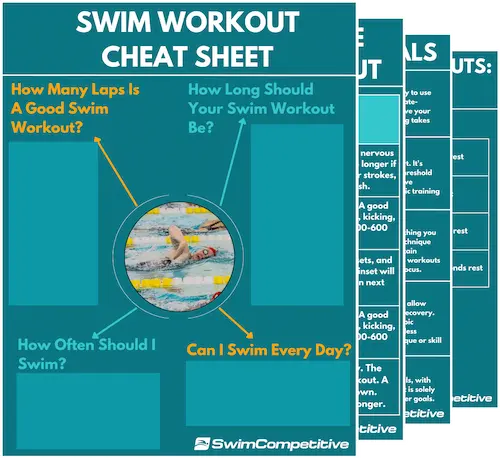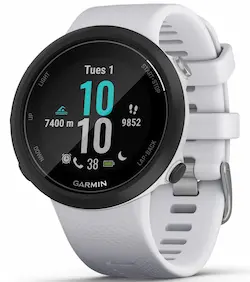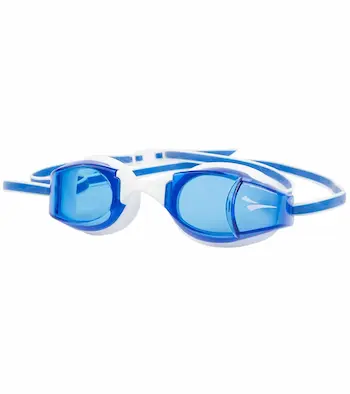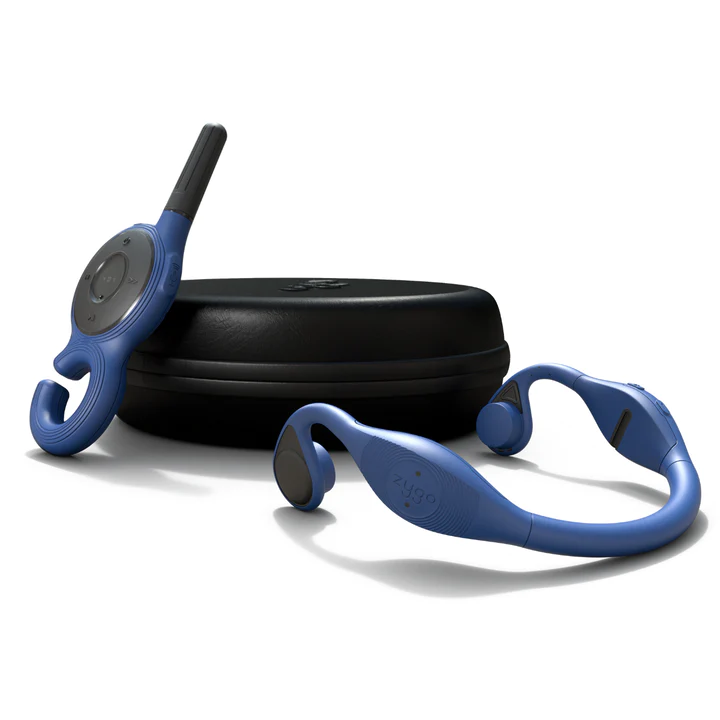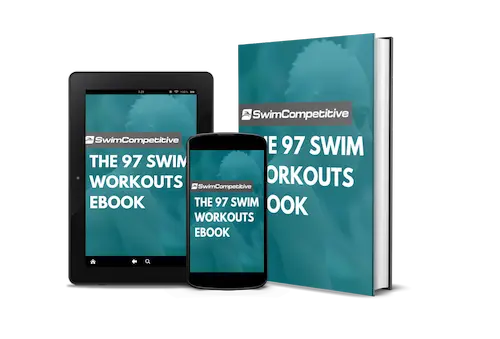It’s widely accepted that swimmers are some of the fittest and most well-rounded athletes out there– chiseled and toned into athletic perfection through endless laps in the pool.
But that leaves us with a question: how many laps is a good swim workout?
Understanding how many laps make up a good swim workout and how it fits into your swimming and health goals is crucial to know if you want to make the most of your time in the pool and reap the countless benefits of swimming.
In this article, I will cover everything you want to know about getting in a good swim workout. This includes:
- Guidelines on the number of laps you should swim for a good swim workout.
- How many times per week you should swim.
- How to easily track your laps while swimming.
- How many laps you should swim to lose weight?
- Tips for a good swim workout and making efficient progress in the water.
- How to structure your swimming workouts and example workouts.
- Incorporating cross-training into your routine.
How Many Laps Is a Good Swim Workout?
Short Answer: For a good swim workout, beginners should swim 30-40 laps (750-1000 meters/ yards), intermediate swimmers should swim 60-100 laps (1500-2500 meters/yards), and advanced swimmers should swim 160-200 laps (4000-5000 meters/yards). The duration of the workout will increase as you swim more laps.
For a more in-depth explanation, continue reading.
Important Terminology: What is a Lap in Swimming? And Long Course Vs. Short Course
Before I can give you an answer, it’s important to understand some basic terminology to avoid confusion.
What is a Lap in Swimming?
Often, many beginner swimmers believe a lap is swimming from one end of the pool to the other and then back again. Or, put simply– swimming 2 lengths.
This is, in fact, not the case. In swimming, a lap and a length are the same things. Meaning if you swim from one end of the pool to the other, that counts as 1 lap.
Therefore, this will be our definition of a swimming lap for this article.
Swimming Lap: Swimming from one end of the pool to the other. Also referred to as a length.
If you’d like to learn more about this or disagree, you can read my article: “What is a lap in swimming?” where I break down and debunk the topic.
Long Course Vs. Short Course
Long course refers to a 50m Olympic-sized pool, while short course refers to a 25m or a 25-yard pool, depending on what you have available.
Due to these differences, the number of laps you swim to achieve a good workout will be different depending on what length of pool you train in.
Don’t worry, though, I will provide separate guidelines for each pool length.
The Simple Answer: How Many Laps is a Good Swim Workout?
When it comes to how many laps you should swim for a good workout, there are two answers– a simple one and a more complex one. For the sake of simplicity (no pun intended), let’s start with the simple answer.
The following guidelines have been derived from my years of swimming experience.
The guidelines take a general swimming workout into account. This means workouts that include:
- A warmup and cool down
- Technique and drill work
- Speed work
- Different sets
- Rest periods
- Made up of different swimming strokes
If you only swim continuous laps up and down, you’ll likely be able to complete more laps in the same timeframe.
That said, I wouldn’t recommend it. Following a structured workout is a far better approach than swimming up and down without any real intention.
The guidelines below are for short course pools. This means 25 meters or yards. If you’d like to see the number for a long course pool, refer to the table below or divide the recommended number of laps in half.
Beginner swimmers: Swim 30-40 laps or 750-1000 meters/ yards for a good swim workout. When starting out, shorter workouts lasting 20-30 minutes should be adequate to complete the recommended number of laps.
Intermediate swimmers: Swim at least 60-100 laps or 1500-2500 meters/ yards for a good swim workout. Workouts lasting an hour should be adequate to complete the recommended number of laps.
Advanced swimmers: Swim at least 160-200 laps or 4000-5000 meters/ yards for a good swim workout. Advanced swimmers will need more training time and can expect workouts to last 1.5 to 2 hours to complete the recommended number of laps.
| Swimmer Level | Laps (Short Course) | Laps (Long Course) | Workout Duration | Distance (meters/yards) |
Average Lap Pace (laps per minute) |
| Beginner | 30-40 | 15-20 | 20-30 minutes | 750-1000 | 1-1.3 |
| Intermediate | 60-100 | 30-50 | 1 hour | 1500-2500 | 1-1.6 |
| Advanced | 160-200 | 80-100 | 1.5-2 hours | 4000-5000 |
1.5 Hours: 1.7-2.2 2 Hours: 1.3-1.6 |
Pro Tip: If you have time restrictions and can’t complete the recommended workout durations, that’s okay! Using the average lap pace, you can calculate what a good workout will be for the time you have available.
For example, let’s say you’re an intermediate-level swimmer, and you only have 45 minutes available to swim on a particular day. In this case, you would use the recommended average lap pace of 1-1.6 laps/ minute. If you multiply this pace by 45 minutes, you get a workout of 45-72 laps.
Here’s the calculation:
- 45 (minutes) x 1 (lap pace/minute) = 45 laps (1125 meters/ yards)
- 45 (minutes) x 1.6 (lap pace/minute) = 72 laps (1800 meters/ yards)
If you follow those guidelines, you should be able to get in a good swim workout every time you hit the pool and dish out some lengths. Whether it may be for 30 minutes or for 2 hours, it all depends on your goals and where you want to take your swimming.
Regarding whether you train in yards or meters, it doesn’t matter too much for the average swimmer since there is only a slight difference in distance between the two.
That said, if you swim in yards and want to ensure you get the complete package, I recommend adding a few extra laps to the guidelines.
It is also essential to take into account that some swimmers, especially beginners who are new to the sport of swimming, may get bored quickly by only swimming up and down until they hit their goal number of lengths for that swim workout.
That’s why I recommend that you follow a well-structured swimming program, join a swim club, or at the very least, compile a list of some excellent and challenging swim workouts you can cycle through.
This will make your swimming much more exciting, enjoyable, and effective. You’ll also be more motivated to hit the pool and train hard next time you have to swim.
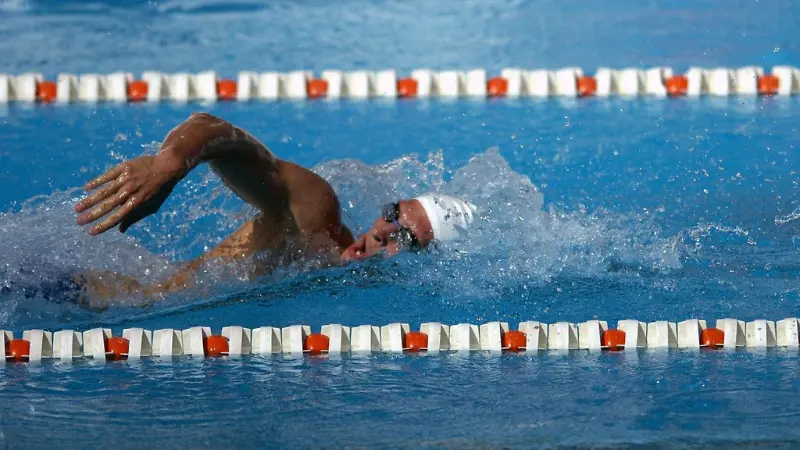
The Not-So-Simple Answer: How Many Laps is a Good Swim Workout?
The total number of laps swam is often something beginner and even intermediate-level swimmers pay a lot of attention to.
And it makes sense why they do this.
When you’re just starting out or still building up swimming experience, it can be a good and straightforward indicator of progress. It’s often motivating to see that number gradually increasing as you slowly become a better swimmer.
But in truth, a good swimming workout doesn’t depend solely on the number of laps you dish out or how long the swim workout is, but rather the goal, intensity, and aim of those swimming laps.
For example, an advanced swimmer could swim 16 laps (8×50’s, short course) at maximum intensity in 30-40 minutes, depending on their interval. In this case, it would mean an interval of 4-5 minutes per 50. That might seem like a lot of rest, but when you give it your all, it won’t feel that way.
Or alternatively, they could swim up to 100 laps in that same timeframe simply by swimming continuously at a moderate pace.
The point I’m making is that there really isn’t a set amount of laps that you ‘should’ be swimming for a good workout.
At the end of the day, it all depends on the goal of the workout.
Suppose you are working on improving aerobic endurance. In that case, you’ll swim more laps in the same amount of time than if you were working on top-end sprinting speed or focusing on swimming slowly and paying particular attention to your technique.
Therefore, the number of laps you swim to get in a “good workout” will vary as you go through different phases of training.
How Many Times a Week Should I Swim?
Short Answer: Beginner swimmers should swim two to three times a week. Intermediate swimmers should swim four to five times per week, while advanced swimmers will train anywhere between six and ten times a week.
Your weekly training frequency goes hand in hand with completing a good swim workout every time you swim.
It doesn’t help to crush a good swim workout and then not swim at all for the next 2 weeks. You must stay consistent if you want to see good results in the pool.
“I think in order to be great, you have to be consistent. Come to practice every day with the mentality that you’re going to improve. If you do that throughout a long season, by the end of the season, you’re going to have come pretty far.”
– Ryan Murphy (6x Olympic Medalist)
With that said, here are some guidelines for how many times per week you should swim:
| Swimmer Level | Workout Frequency (per Week) |
| Beginner | 2-3 |
| Intermediate | 4-5 |
| Advanced | 6-10 |
For advanced swimmers, this would mean double workouts on some days. Aim to have at least one rest day each week where you don’t train.
Is It Okay to Swim Every Day?
If you are a true swim fanatic, you might be wondering whether or not you can swim every day and whether it’s healthy.
Short Answer: Yes, you can swim every day, and it is completely fine to do so. Swimming is a low-impact sport and doesn’t place as much stress on joints and muscles as other physical activities like running or lifting weights.
It is, however, essential to ensure that your body is getting adequate recovery if you swim every day of the week. You need to be able to recognize when it feels like you are getting overtrained or under-recovered and to take a day off when needed.
How to Easily Track How Many Laps You Swim
Now that we’ve discussed the basics, I want to share a few methods for easily tracking your laps.
Keeping count in your head is tedious, and it’s easy to forget how far you’ve swum if you get distracted even for a few seconds.
Luckily there are many great tools out there that will help you to track your laps. And if you are willing to spend a bit extra, some tools can help you track many other interesting metrics, such as your heart rate, pace, stroke count, and more!
Budget Method for Tracking Laps
A manual hand-operated lap counter is the simplest and cheapest method to track your laps. This is a little waterproof device that you can wear on your index finger. Whenever you finish a lap, you press a button, and the device will add it to the count.
This is an excellent option if you’re looking for something simple and cheap that gets the job done.
Easily and effortlessly track your laps in the pool with the simple press of a button. No more losing count!
More Advanced Methods for Tracking Laps
There are various other tools available for tracking laps. These include:
- Smartwatches
- Smart swim goggles
My favorite smartwatch for swimming is the Garmin Swim 2. This watch has all of the necessary features for swimmers.
The smart swimming goggle I recommend is the FINIS Smart Goggles. Like the Garmin Swim 2, these goggles track a plethora of metrics. I prefer the smart goggles over the smartwatch since they don’t add unnecessary weight to my wrist while swimming. It’s also much easier to look at the display when swimming compared to the watch.
The FINIS Smart Goggle is the most innovative smart swimming goggle available.
Directly display and track your laps, splits, set time, rest time, stroke rate, and more in your goggles with the non-intrusive heads-up display while swimming.
Bonus: Keep Your Mind Occupied with a Pair of Swimming Headphones
If you swim on your own, it can occasionally get a bit tedious. A pair of swimming headphones can help eliminate this issue by allowing you to listen to your favorite music or podcasts while you swim.
I recommend the Zygo Swimming Headphones. Unlike most other swimming headphones that require you to upload your audio files directly to the device, these can stream audio straight from your smartphone.
The Zygo app also has guided swim workouts that you can stream while swimming.
Stream music, podcasts, audiobooks, and more from any device directly to the innovative Zygo swimming headphones. Download the Zygo App for guided audio workouts, music, and more. The transmitter also enables live coaching.
How Many Laps Should I Swim to Lose Weight?
When it comes to losing weight, it isn’t necessarily about the number of laps you swim but rather about the amount of energy you consume versus the amount of energy you burn.
Energy In, Energy Out
This energy is typically described as calories or kilojoules.
In short, if you want to lose weight, you need to consume less energy than you burn.
Typically, I recommend being in a calorie deficit of about 500 calories per day. One pound of fat equals roughly 3500 calories. Therefore with a deficit of 500 calories per day, you’ll lose approximately 1 pound per week.
It’s important to note that although these estimates can work well in the short term, they don’t accurately reflect long-term weight loss due to changes in the body.
These estimates were developed in the 1950s and have since been shown not to be as accurate over the long term as previously believed.
“When you reduce calorie intake, your body responds by making you burn fewer calories. You start moving around less, and the body becomes more efficient. It does the same amount of work, but it uses fewer calories than before.”
– Healthline
To counter this, you’ll have to gradually increase your calorie deficit as time goes by to keep losing weight.
Keeping things simple, let’s say you are eating at a maintenance level (meaning you eat as many calories as you burn in a day, thus not gaining nor losing weight). In that case, the table below shows how many laps you’d have to swim to lose 1 pound per week when swimming at an average pace, which is estimated to be about 2 miles per hour.
It’s important to note that these are only rough estimates. The number of calories you burn will depend on several factors, such as:
- Your weight.
- Your swimming speed (intensity).
- The strokes you swim.
- Your genetics: some people naturally burn more calories than others when doing the same activity at the same intensity.
Therefore, the most accurate way to determine how many calories you burn in a workout would be by using a swimming tracker like the FINIS Smart Goggles or the Garmin Swim 2.
You can also use a calorie calculator if that’s not an option. Click here for the calculator I used to calculate the values in the table. It’s not as accurate as a tracker but should give you a rough overview.
| Bodyweight (Ibs) | Calories Burned | Laps (25m) | Duration (minutes) | Distance (meters) | Stroke | Swimming Speed |
| 120 | 500 | 134 | 63 | 3350 | Freestyle | 2 miles per hour |
| 160 | 500 | 100 | 47 | 2500 | Freestyle | 2 miles per hour |
| 200 | 500 | 80 | 38 | 2000 | Freestyle | 2 miles per hour |
| 240 | 500 | 67 | 32 | 1675 | Freestyle | 2 miles per hour |
Related: 9 Swim Workouts for Weight Loss.
Dietary Adjustments for Losing Weight
Unfortunately, for most people, swimming alone won’t be enough to achieve your goal of losing weight. This is because most people aren’t eating at a maintenance level of calories and are likely consuming more calories than they are burning in a given day.
Thus swimming should only be seen as a tool that can aid you in achieving the energy deficit required for weight loss.
You’re most likely also going to have to make dietary adjustments to ensure that you are in a calorie deficit. This could mean eating slightly less than you do in a typical day, or it could mean eating healthier foods that are less calorie-dense (the method I recommend).
Make sure to still include plenty of protein-rich foods like eggs, chicken, and beans to ensure your muscles can repair and recover after workouts.
If you’d like to learn more about this, I highly recommend reading my article on how to create a meal plan for swimmers. I’ll show you exactly how to determine your energy needs and put together a diet plan to help you lose weight.

Swimming Intensity Vs. Distance for Losing Weight
Another factor to consider when swimming laps to lose weight is your training intensity.
A higher intensity would mean that you’d burn more calories per lap, but it would also mean that you’d swim fewer laps in total as you’ll require more time to rest and recover.
Let’s run a quick case study to determine the more efficient option.
For our example, we will use a 150 Lbs advanced level swimmer (as this affects the number of calories burned).
At a moderate intensity, their base pace is 25 seconds per lap, as they won’t have to stop for rest. But at a vigorous pace, their base pace is 40 seconds per lap, as they’ll require rest every few laps.
According to another calorie calculator, a 150 Lbs person swimming freestyle at a moderate pace will burn 208 calories in 30 minutes, while they will burn 351 calories per minute swimming at a vigorous pace.
Using these numbers, I devised a set of calculations to determine a real-world reflection of how many calories you can expect to burn in total.
Once again, these calculations are only estimates and will differ when you test them with a swimming tracker. Still, I think they reflect what you can expect in the real world quite well. Namely, you’ll burn more calories swimming at a sustained moderate pace than swimming short sprint bursts with additional rest in between.
| Swimming Intensity | Calories Burned per Lap | Laps in 30 Minutes | Total Calories Burned in 30 Minutes | Stroke |
| Moderate (2 miles per hour) | 3.24 | 72 Laps (25 seconds per lap) | 233.28 | Freestyle |
| Vigorous (3 miles per hour) | 3.64 | 45 Laps (40 seconds per lap) | 163.80 | Freestyle |
Do You Want to Make Every Lap Count?
Stop wasting your time in the pool feeling lost and doing directionless swim workouts, and start training effectively! Our ebook contains 97 structured and goal-orientated swim workouts to help you become a better, faster, and fitter swimmer. Whether you’re a complete beginner or a seasoned pro, there are a multitude of workouts for every type of swimmer.
These numbers, however, paint only part of the picture.
In another article, I discussed the phenomenon of excess post-exercise oxygen consumption (EPOC), also commonly known as the “afterburn effect.”
To explain it simply, excess post-exercise oxygen consumption is an increase in resting energy expenditure that occurs after exercise to help your body recover and repair.
The effects of this process are most prominent after an intense workout.
One study published in the Journal of Medicine and Science in Sports and Exercise found that participants’ metabolic rate increased for a whopping 14 hours after a vigorous 45-minute cycling workout. They ended up burning 190 extra calories than on days when they didn’t exercise purely due to their increased metabolic rate.
These findings are further supported by another study published in the Journal of Strength and Conditioning Research. In the study, participants did 3 bike workouts of different intensities.
This study found that more calories were burned after exercise by those who did the more intense workout. Still, most of those calories were burned in the first hour after training. By the third hour, the difference in EPOC was less than five calories between the 3 intensity groups.
Based on these studies and the numbers calculated above, it’s hard to say which approach is better for burning the most calories through swimming– lower intensity and more distance or higher intensity and less distance?
If your goal is purely to burn as many calories as possible, the safe bet would be to incorporate a combination of both.
Structure your workout so that most of it is focused on lower intensity, sustained swimming, but also make room to incorporate a few laps of high-intensity sprints where you take extra rest.
This will make your swim workout more enjoyable anyway by breaking things up and allowing for some variety.
And at the end of the day, that’s the most important thing– how much you enjoy it. Because if you enjoy swimming, you’ll be more likely to stick to it and reach your goals.
How Many Laps Should I Swim in 30 Minutes?
Short Answer: Based on our recommended guidelines, beginner swimmers can expect to swim 30-40 Laps in 30 minutes. Intermediate swimmers can swim 30-50 laps in 30 minutes. And advanced swimmers should be able to swim 51-66 laps in 30 minutes.
Using the formula created earlier based on the recommended guidelines for how many laps you should swim for a good workout, here is how many laps each level of swimmer should expect to swim in 30 minutes.
| Swimmer Level | Number of Laps in 30 Minutes (Short Course) | Swimming Pace (Laps per Minute) |
| Beginner | 30-40 | 1-1.3 |
| Intermediate | 30-50 | 1-1.6 |
| Advanced | 51-66 | 1.7-2.2 |
10 Tips for a Good Swim Workout and Making Efficient Progress in the Water
Here are some tips for making the most of your swim workouts.
1. Focus on Nailing Your Swimming Technique
The first aspect of a good swim workout is swimming all the strokes well. The 4 main swimming strokes include butterfly, backstroke, breaststroke, and freestyle.
If you’re purely a lap swimmer, you’ll most likely want to work on learning decent freestyle swimming technique first. Once you’ve got that down, improve your backstroke and breaststroke. Butterfly is typically considered the hardest of the four and should be learned once you have more experience in the water.
Good technique is a critical part of swimming fast and efficiently.
If you don’t take the time to learn the basic swimming technique for each stroke, you’ll have a hard time getting in a good swim workout.
Here’s a short video explaining proper freestyle swimming technique-
2. Set Goals for Your Swimming
Goal setting is crucial for any athlete, whether you are a beginner or an elite-level Olympic swimmer– you need goals.
Goals help you determine what you should be doing in the water and how to get there.
They also play a significant role in motivating you to get to the pool on tough days when you don’t feel like training by reminding you of the bigger picture. Your goals can be basic- like being able to swim a mile in under 30 minutes or losing 5 pounds.
They can also be more challenging, like swimming a 100 freestyle in under a minute or qualifying for a big swimming meet.
Make sure to pair your goals with a plan to ensure success!
3. Stay Consistent with Your Swim Training
Consistency is one of the most critical factors in becoming a better swimmer.
If you only show up to training here and there when you feel like it, you will never be able to reach your swimming goals.
It is essential to stay consistent and to show up for training when you need to. No matter if you feel like it or not.
4. Create Your Own Swimming Program and Training Schedule
A swimming program and a training schedule are highly beneficial for any swimmer.
As a matter of fact, it is indispensable.
You need to have a training schedule of which days you will train and at what time. This will get your body into a routine and further solidify your training consistency.
Pro Tip: Initially structure your training schedule to make it easy for you to stick to it. It’s all about building up enough momentum until swimming has become a habit that you can stick to, regardless of whether or not you are in the mood to train.
Similarly, a swimming program is essential to know what you should be doing in the pool on a particular day and to make efficient progress.
If you show up for training without a proper workout, you will flop around and make minimal progress, if any at all. Your workouts should slowly increase in difficulty as you become fitter and stronger to continue progressing.
5. Incorporate Swimming Drills and Technique Sets into Your Swimming Workouts
This goes hand in hand with learning proper swimming technique for each stroke.
Swimming drills are a great way to focus on specific aspects of your stroke and improve areas where you might be lacking- like hand entry or head position.
Try to incorporate a minimum of 200-300 meters/ yards of drills into your swim workouts, or make them a part of your warmup routine when you jump in.
Related: 10 butterfly swimming drills.
Technique sets are also a useful way to work on becoming a more efficient swimmer.
In its essence, a technique set is a set where you swim normally but focus on a specific part of your stroke.
Usually, I’d recommend swimming a bit slower than usual to ensure you are doing everything correctly. You can also use swimming gear to help with certain parts of your stroke during technique sets.
For example:
- Paddles to help with your hand entry and pull.
- Fins to help with your kicking.
- Snorkel when working on body position, head position, or need to eliminate the need for breathing to focus more effectively on other parts of your stroke.
A simple example technique set could be:
- 5x100s freestyle on 1:45 w/ paddles focusing on a clean hand entry and early vertical forearm position during the catch.
6. Use Intervals in Your Swim Workouts
Once you start to master the basic swimming technique and build up fitness and endurance, it can be valuable to incorporate timed interval swimming.
This means swimming X amount of distance in Y amount of time.
For example, you can do 10x50s freestyle on 1 minute as a start, and then slowly decrease the time you have to swim each 50 as you get more experienced in the water.
- Week 1: 10x50s freestyle on 1:00
- Week 2: 10x50s freestyle on 0:58
- Week 3: 10x50s freestyle on 0:56
- Week 4: 10x50s freestyle on 0:55
The FINIS Smart Goggle can help you easily achieve this by displaying intervals right in your goggles while you swim.
The FINIS Smart Goggle is the most innovative smart swimming goggle available.
Directly display and track your laps, splits, set time, rest time, stroke rate, and more in your goggles with the non-intrusive heads-up display while swimming.
7. Stock Up on the Right Swim Gear
There is a lot of swimming gear available, and for good reason too.
Swimming gear can be a valuable aid in improving certain aspects of your swimming. As discussed earlier, one use case could be for improving your swimming technique. But swimming gear can also help improve other aspects of your swimming like:
- Strength
- Speed
- Power
- Fitness
For example, you can use swimming fins to improve power in your kicking. You can use a kickboard to increase kicking speed, paddles to improve your pulling strength, and a snorkel to improve your breathing efficiency and cardiovascular conditioning.
8. Mix Up Your Swimming Strokes During Workouts
Many swimmers get stuck in the habit of only training their best strokes or the stroke they are most comfortable with and is the easiest for them.
This is only an effective strategy if you are a professional swimmer training to specialize in a particular swimming stroke or event.
95% Of swimmers should be swimming all 4 strokes each workout. This doesn’t necessarily mean you have to swim them in equal amounts but try to mix things up and not to get stuck on only swimming 1 particular stroke.
By using multiple strokes, you will work different muscles and swimming techniques, making you a more well-rounded and better swimmer overall.
Pro Tip: I recommend swimming a decent amount of backstroke each workout. All of the other strokes tend to pull your shoulders forward due to the muscles they use. This can create muscle imbalances and bad posture over a long enough timeframe. Backstroke is a way to counteract this and balance things out.
9. Use a Swim Log
Self-reflecting on your workouts is one of the most important things you can do to ensure effective progress in the pool.
And the sad part? Most swimmers don’t use one!
Suppose you complete a swim log regularly after each workout. In that case, you’ll soon enough start to notice where your deficiencies are and whether or not you are making progress.
This will allow you to adjust your training on the go to ensure you are always on the right track and moving toward your goals.
Here is a basic outline for how you can structure your swimming log-
- The swim workout: write down the day’s workout. Include things like the distance you swam, your times, etc.
- Things that you worked on during training and give yourself a rating out of 10 for each. Usually, I try to keep these similar over a longer period until I’ve mastered them before moving on to something else.
- Areas where you went wrong and what you can do to correct it in the following workout.
Once you are comfortable using a swimming log, you can incorporate something similar into your daily life for your personal goals. Usually, this will be in the form of a journal. It’s something I do, and I can attest to its effectiveness.
10. Make Sure You Are Recovering Properly
It’s all good and well to train hard, but if you aren’t recovering properly between workouts, you won’t be able to sustain your progress. What’s more, is that you’ll be putting yourself at risk of injury.
Recovery can be simple and can include things like:
- Eat enough protein and calories for muscle regeneration and fuel your body with nutritious foods.
- Eat at the correct times (eat something small and protein-dense within 30 minutes after your workout to immediately start the recovery process).
- Get adequate sleep.
- Foam rolling and stretching.
- Drink enough water.
- Ice-baths.
- If you swim more than 5 times per week, include a recovery workout. This is an excellent opportunity for swimming slower and working on your technique.
How to Structure Your Swimming Workouts
Now that we’ve covered all of the important questions and set you up for success in the pool, you might be wondering how to structure your swimming workouts.
Basic Outline for an Efficient Swim Workout
Each swimming workout should consist of a few main parts. This includes:
- Warmup: Usually between 300-800 meters/ yards in distance (can be longer depending on the workout).
- Pre-set (optional): Whether or not you include it will depend on your workout goals and if you have enough time/distance to include it. It’s a good place for adding drills, technique, or breathwork. Or anything specific you want to work on during a workout, like underwaters. It’s usually not too long and can be between 300-600 meters/ yards in distance.
- Mainset: This usually makes up the bulk of your workout. The mainset can be divided into subsets and multiple rounds for more advanced workouts.
- Post-set (optional): This is similar to the pre-set, and whether or not you include it will depend on your workout goals and if you have enough time/distance to include it.
- Cooldown: Usually between 200-800 meters/ yards in distance. The distance of your cooldown depends on the intensity of your workout. If you did a lot of intense sprints or interval work, a longer cooldown is recommended.
The Goals of Swimming Workouts (Mixing Things Up)
Now that you have a basic outline of what the general structure of your swimming workout should look like, I want to bring your attention to the fact that there are different things to work on during workouts. Mixing your workouts up and working on all of these various aspects is essential.
Goals of swimming workouts:
- Aerobic conditioning (endurance, cardio, fitness).
- Anaerobic conditioning (sprinting, speed, power, lactate tolerance).
- Technique.
These are generally the most important, although there may be other things to work on as well. If you want to make sure you get the full spectrum out of your training, you can join a swim club where a coach will take all of the thinking out of the process, and you can focus purely on training.
3 Example Swimming Workouts for Every Level of Swimmer
Below are a few basic examples of some good swimming workouts that you can incorporate into your swimming program and adjust to make them easier or more challenging.
You can also use them as a reference for creating your own workouts from scratch. Make sure to look at all of the workouts, regardless of what level of swimmer you are, as you can incorporate different aspects of each workout into your own.

Swimming Workout 1- Beginner Swim Workout (30 Minutes)
- Warmup: 4x50s alternating freestyle and backstroke by 50, 15 seconds rest.
- Pre-set: 4x25s choice drills, 10 seconds rest.
- Mainset: 5x100s choice stroke, 30 seconds rest. Focus on 1 technical point of your stroke while swimming.
- Cooldown: 200 easy backstroke swim.
- Total Distance: 1000 meters/yards.
- Laps (Short Course): 40 Laps.
- Duration: 32-35 minutes.
- Workout Focus: Aerobic fitness and technique.
Workout Terminology:
- Alternating = changing strokes.
- Choice = You decide during the workout.
Swimming Workout 2- Intermediate Swim Workout (50 Minutes)
- Warmup: 500 easy swimming (alternate 100 freestyle, 100 drills)
- Pre-set: 8x50s kicking w/ fins and a kickboard, 20 seconds rest.
-
Mainset:
- Subset 1: 8x100s freestyle build w/ paddles on 2:00. Build from numbers 1-4 and 5-8. 100 Recovery swim before subset 2.
- Subset 2: 4x25s choice sprint, no equipment, 45 seconds rest.
- Cooldown: 300 easy choice swim.
- Total Distance: 2200 meters/yards.
- Laps (Short Course): 88 Laps.
- Duration: 50-56 minutes.
- Workout Focus: Aerobic speed, minor sprint work.
Workout Terminology:
- Build = from slow to fast.
- On 2:00 = on 2 minutes (interval).
- Recovery = easy swimming, any stroke, usually freestyle or backstroke.
Swimming Workout 3- Advanced Swim Workout (2 Hours)
- Warmup: 800 backstroke swimming.
- Pre-set: 12x25s underwater dolphin kick w/ fins on 0:45.
-
Mainset:
- Subset 1: 16x100s IM on 1:45, no equipment. 200 Recovery swim before subset 2.
- Subset 2: 10x50s kicking w/ board and fins on 1:00, max speed. 200 Recovery kick before post-set.
- Post-set: 4x100s drills, any equipment, 15 seconds rest.
- Cooldown: 500 easy freestyle w/ snorkel.
- Total Distance: 4500 meters/ yards
- Laps (Short Course): 180 Laps.
- Duration: 1 hour 45 minutes – 2 hours.
- Workout Focus: Aerobic endurance, kicking speed.
Suppose you want some more swimming workouts and examples. In that case, I recommend you check out my article on these 12 awesome swimming endurance workouts.
Spicing Up Your Workouts with Cross-Training
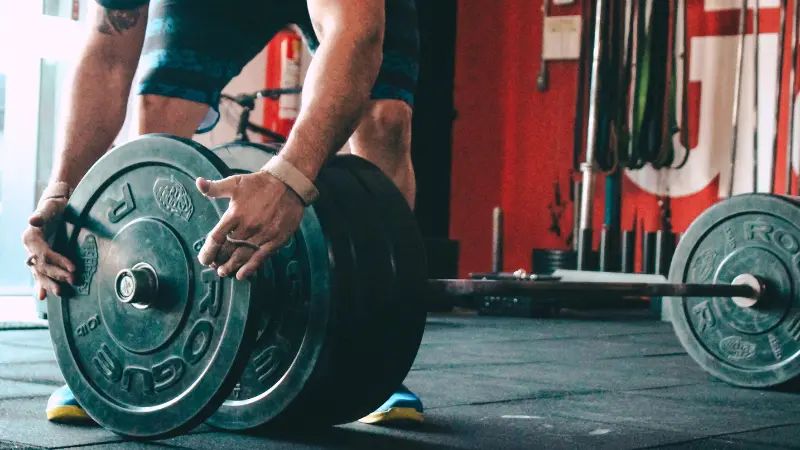
Almost all competitive and elite-level swimmers incorporate other forms of training into their regime.
It may be running, lifting weights, cycling, or doing various bodyweight workouts.
I highly recommend you do the same, even if you aren’t at the elite level.
For example, if you swim three days a week, you may do some running or weight lifting on your off days. Bodyweight workouts, such as calisthenics, can also provide significant benefits in terms of building extra strength, power, and muscle.
Other cross-training activities can include things like stretching or yoga. Flexibility and mobility are crucial for any athlete and especially for swimmers. It enables proper movement in the water and on dryland.
I recommend you do a combination of flexibility work and strength training if you decide to mix cross-training into your training routine.
Swimming already trains your cardiovascular system and conditioning adequality, so there isn’t much of a need to incorporate other dryland cardio activities.
It’s also important to note that flexibility and strength are equally important, but if you lack flexibility, I recommend prioritizing that.
Suppose you can’t move properly to start with. In that case, you’ll have a rough time training for strength as you’ll lack the range of motion to perform exercises correctly, let alone swim efficiently. You’ll also be putting yourself at risk of injury.
Strength training can include:
- Lifting weights.
- Doing medicine ball workouts.
- Exercising with resistance bands.
- Hitting the pull-up bar for a calisthenics workout.
This will help to strengthen muscles that can prevent injury in the pool and aid in swimming faster and more efficiently.
Reaching Your Goals Is More Than Just the Number of Laps You Swim
At the end of the day, swimming is more than the number of laps or the total distance you swim in each workout– it’s much more complex than that.
There are a hundred little details that swimmers should focus on to become better and faster.
For example- improving your swim technique, skills, strength, power, and flexibility, to name a few.
That said, it’s essential to start somewhere. By following the guidelines and workouts I have provided in this article, you can gradually build up your overall conditioning and move closer to reaching your fitness and swimming goals.
